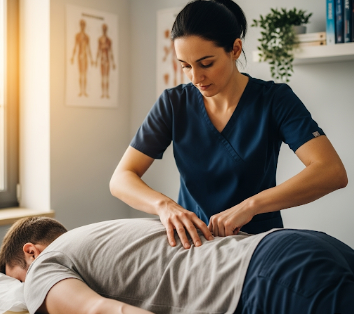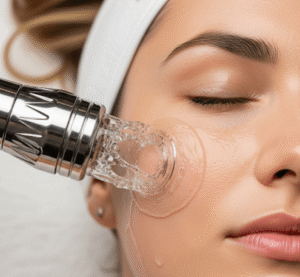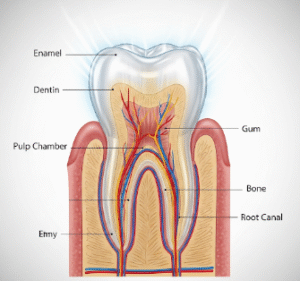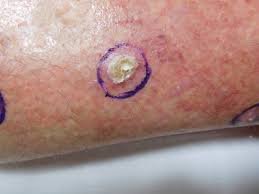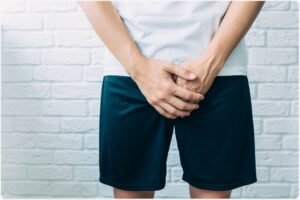What it is
Osteopathy is a holistic approach to healthcare that focuses on the musculoskeletal system and its relationship with overall health. Osteopaths use manual techniques, including stretching, massage, and joint manipulation, to improve mobility, relieve pain, and support the body’s natural healing mechanisms.
Key points:
- Treats conditions related to muscles, joints, ligaments, and connective tissues.
- Emphasizes prevention, holistic care, and individualized treatment plans.
- Used for musculoskeletal pain, postural problems, and some chronic conditions.
- Integrates with conventional medicine when necessary to provide comprehensive care.
Osteopathy is widely recognized for enhancing mobility, reducing pain, and improving overall physical function, making it a valuable option for patients seeking non-invasive therapies.
Why it’s done
Osteopathic treatment is recommended for a variety of conditions:
- Musculoskeletal pain: Back pain, neck pain, joint stiffness, and muscle tension.
- Postural problems: Caused by prolonged sitting, repetitive movements, or poor ergonomics.
- Sports injuries: Sprains, strains, and overuse injuries.
- Chronic conditions: Headaches, migraines, and fibromyalgia.
- Recovery support: Post-surgical rehabilitation or injury recovery.
- Functional improvement: Enhances circulation, flexibility, and mobility.
Benefits of osteopathy:
- Reduces pain and discomfort without the use of medication.
- Improves range of motion and physical performance.
- Supports healing and recovery from injuries.
- Addresses underlying structural issues, rather than just symptoms.
Alternatives
Other therapeutic options that may complement or serve as alternatives to osteopathy include:
- Physiotherapy (Physical Therapy): Focuses on strength, flexibility, and functional exercises.
- Chiropractic care: Primarily targets spinal alignment and joint manipulation.
- Massage therapy: Helps relieve muscle tension and stress, but does not correct structural alignment.
- Acupuncture: Uses needle stimulation to relieve pain and improve circulation.
- Medical management: Painkillers or anti-inflammatory medications for symptom relief.
Important: Osteopathy is unique in its holistic approach, combining structural correction with functional and preventive care.
Preparation
Preparation for an osteopathic session is minimal but can enhance treatment effectiveness:
- Medical history: Provide the osteopath with information about injuries, surgeries, chronic conditions, and medications.
- Comfortable clothing: Wear loose, flexible clothing to allow full movement during assessment and treatment.
- Hydration: Being well-hydrated supports tissue health and recovery.
- Pre-treatment discussion: Discuss goals, areas of pain, and desired outcomes with the practitioner.
Patient instructions:
- Arrive a few minutes early to relax and discuss your condition.
- Avoid heavy meals or strenuous activity immediately before treatment.
- Communicate any discomfort or medical concerns during the session.
How it’s done
Osteopathy is a hands-on, individualized therapy:
- Initial assessment:
- Osteopath evaluates posture, gait, joint mobility, and muscle tone.
- Identifies areas of restriction, imbalance, or dysfunction.
- Treatment plan:
- Tailored based on assessment findings and patient goals.
- May involve manual manipulation, stretching, soft tissue massage, or joint mobilization.
- Therapeutic techniques:
- Soft tissue techniques: Massage, stretching, and myofascial release to relax muscles.
- Articulation and joint mobilization: Gently moves joints through their range of motion.
- Cranial osteopathy: Light manipulation of the skull and spine to improve overall function (used selectively).
- Exercise prescription: Targeted exercises to strengthen muscles and improve posture.
- Monitoring and follow-up:
- Progress is assessed during each session.
- Treatment intensity and focus are adjusted to optimize outcomes.
- Sessions may be scheduled weekly or biweekly, depending on condition severity.
Duration: Each session typically lasts 30–60 minutes, with the number of sessions varying based on the condition.
Recovery / Post-Treatment Considerations
After osteopathic treatment:
- Immediate effects: Some patients experience mild soreness or fatigue, which usually resolves within 24–48 hours.
- Hydration and rest: Drinking water and resting helps flush out toxins and support healing.
- Home exercises: Osteopaths may recommend stretching, strengthening, or posture exercises.
- Follow-up: Regular sessions may be necessary to maintain long-term benefits.
Benefits:
- Reduces pain and muscle tension.
- Improves joint mobility and flexibility.
- Enhances circulation and lymphatic flow.
- Supports functional independence and physical performance.
Complications / Risks
Osteopathy is generally safe, but some minor risks may occur:
- Temporary soreness or stiffness in treated areas.
- Fatigue or mild headache post-session.
- Rare adverse events: Very rarely, injury to tissues or joints may occur if improperly performed.
Prevention / Management:
- Treatment is provided by licensed and trained osteopaths.
- Sessions are adjusted to patient comfort and health status.
- Patients are encouraged to communicate discomfort immediately.
- Pre-treatment assessment ensures any contraindications (e.g., fractures, severe osteoporosis, or inflammatory conditions) are considered.
Treatment Options in Korea
Osteopathy is available in specialized clinics, rehabilitation centers, and integrative health facilities across Korea:
Key features:
- Services for adults, children, and elderly patients.
- Treats musculoskeletal pain, postural issues, sports injuries, and chronic conditions.
- Integrates exercise therapy, ergonomic advice, and lifestyle guidance.
- Often works in collaboration with physicians, physiotherapists, and other specialists.
- Sessions are customized for pain relief, functional improvement, and preventive care.
Benefits in Korea:
- Offers non-invasive pain relief and functional restoration.
- Enhances mobility, posture, and physical performance.
- Supports chronic condition management and recovery after injury or surgery.
- Provides holistic care, addressing both physical symptoms and overall well-being.
Additional Considerations for Patients
- Maintain regular appointments and follow home exercise recommendations.
- Communicate any changes in symptoms or new pain areas to your osteopath.
- Combine osteopathy with physical activity, healthy posture habits, and ergonomic adjustments.
- For chronic or complex conditions, coordinate care with other healthcare providers for optimal outcomes.
Summary: Osteopathy in Korea is a safe, effective, and holistic approach to improving musculoskeletal health, mobility, and overall function. By combining manual therapy, exercises, and lifestyle guidance, osteopaths help patients relieve pain, enhance physical performance, and maintain long-term health and independence.

